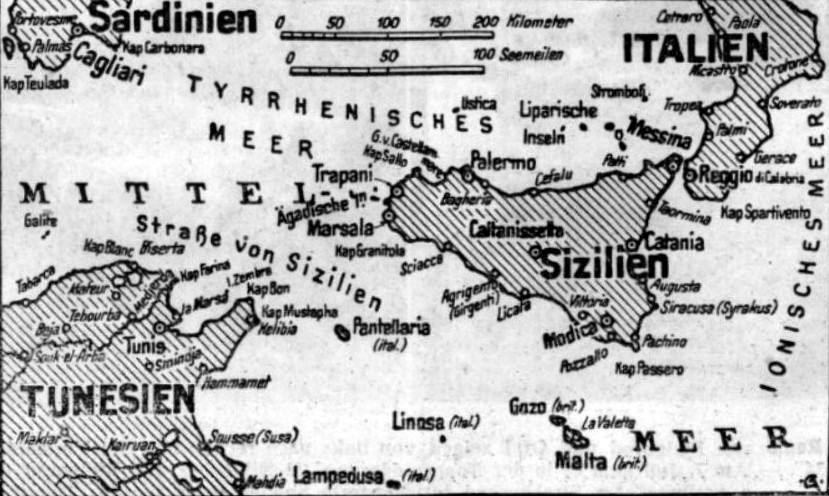La Stampa (July 13, 1943)
L’imponente sforzo anglo-americano e l’inizio della nostra decisa reazione
La preparazione dell’impresa a Gibilterra in Tunisia a Malta non era sfuggita alla nostra osservazione – La vastità dei mezzi impiegati – Le condizioni tattiche per la controffensiva
Nel nostro articolo del 27 giugno avevamo prospettato come l’attacco nemico – che per tanti segni si palesava ormai imminente – sarebbe stato sferrato contro la Sicilia. Facile profezia perché le nostre argomentazioni, pur svolte allora solo in base ad clementi logici e strategici, erano in realtà suffragate da validi dati di fatto.
L’attuale ciclo operativo ha origini assai lontane. Come concezione e impostazione di piani di guerra, si deve risalire almeno all’estate 1942 quando il nemico – sotto l’imperativo di continui rovesci militari e ben conscio che in Mediterraneo era e sarà sempre la chiave del conflitto – decise di puntare tutto il peso delle sue possibilità belliche sulla carta mediterranea, pur con l’inevitabile conseguenza di dover battere il passo e di sacrificare ogni apprezzabile iniziativa su tutti gli altri scacchieri di guerra.
La posta in giuoco
Concentrando in Mediterraneo non soltanto la massima parte, ma anche il fior fiore delle sue forze aeree, navali e terrestri, il nemico è riuscito, in tempi successivi, a realizzare quella prevalenza potenziale nei vari settori, necessaria per la graduale conquista del Mediterraneo, premessa indispensabile affinché le sorti della guerra potessero prendere una piega a lui favorevole. Ma come già accennammo in altra occasione, chiave di volta al dominio del Mediterraneo è il canale di Sicilia, per cui gli anglo-americani dovevano inevitabilmente affrontare, per realizzare i loro piani, il problema della conquista integrale di questo passaggio tentando la occupazione della Sicilia.
I preparativi nemici per tali operazioni sono pure stati di lunga durata, vista la complessità dell’operazione, la imponenza dei mezzi da impegnare e la quasi cronometrica successione e compenetrazione con cui in simili azioni devono agire i singoli elementi delle tre forze armate, pena le più gravi conseguenze in campo tattico; senza contare che il tentativo doveva rappresentare, nelle intenzioni avversarie, la prima stabile presa di terra nel continente europeo dopo il disastro di Dunkerque e il principio dell’apertura di quel «secondo fronte» sul quale sono corsi fiumi di inchiostro e di speranze.
Ma la mole stessa dei mezzi e delle forze da impegnare non poteva passare inosservata e infatti, prima ancora che finisse la campagna tunisina, la ricognizione aerea forni elementi sufficienti a dare la certezza che il nemico si stava preparando ad una futura grande operazione anfibia.
Successivamente si ebbero ripetute conferme della preparazione nemica che, sfruttando la favorevole situazione strategica, poteva essere agevolmente completata e disposta fuori del limite pratico delle nostre possibilità offensive nei lontani settori e porti dell’Algeria occidentale e del Marocco.
Il concentramento di forze
Negli ultimi mesi lo schieramento nemico si fece sempre più consistente finché nello scorso giugno raggiunse un livello tale de dare già da solo la certezza che l’operazione fosse ormai imminente. Non è ancora il caso né il momento di fare una valutazione delle forze che il nemico ha destinato all’azione, ma si può averne un’idea complessiva considerando che soltanto in fatto di forze navali sono concentrate in Mediterraneo e impiegate contro la Sicilia, sei corazzate (quattro delle quali da 35 mila tonnellate), quattro portaerei di squadra di recente costruzione, una trentina di incrociatori, qualche centinato di unità minori dei vari tipi e un imponente numero di mezzi da sbarco di ogni categoria; il tutto appoggiato da alcune migliaia di aerei.
Naturalmente quasi tutte le forze nemiche sono rimaste dislocate fino agli ultimi giorni nei settori più lontani della zona di impiego, principalmente all’estremo occidentale del Mediterraneo, anche per lasciarci, fin quando possibile, in dubbio se l’attacco sarebbe stato sferrato contro la Sardegna o contro la Sicilia. Ma i movimenti preliminari di una massa di mezzi tanto cospicua, non si possono compiere in ventiquattro ore, cosicché già a meta giugno, con lo spostamento delle forze nelle sedi operative, il nemico fu costretto a svelare – attraverso le nostre ricognizioni aeree – quale fosse il suo reale obbiettivo.
La gran massa delle forze infatti si trovava ormai dislocate nel settore tunisino orientale e a Malta, cioè in funzione di minaccia esclusiva contro la Sicilia. Negli ultimi giorni di giugno lo schieramento e i preparativi del nemico furono compiuti nei finali dettagli, per cui l’attacco si annuncio imminente. E’ nostra personale sensazione anzi, che l’attacco dovesse essere sferrato proprio a fine giugno, ma che qualcosa di imprecisabile non abbia funzionato bene negli ingranaggi anglo-americani cosi da costringere il nemico a ritardare l’azione di alcuni giorni.
Circostanze inevitabili
Poteva lo sbarco essere impedito? Solo circostanze particolarmente fortunate – che non si sono verificate – avrebbero forze potuto consentirlo. Occorre richiamarsi alla precisa definizione data dal Duce di «sbarco-penetrazione-invasione». Lo sbarco rappresenta sempre un’iniziativa del nemico, per cui pur atteso, pur essendo consentito prevedere in quali «zone» sarebbe probabilmente stato tentato, non era possibile, almeno nel caso della Sicilia, prevedere in quale «punto» il nemico avrebbe attaccato. Ne consegue che su un territorio cosi vasto come la Sicilia, con tante ampie zone costiere in cui lo sbarco avrebbe potuto verificarsi, con cosi particolare configurazione del terreno, in funzione della manovrabilità di masse di armati, era materialmente impossibile né rispondente ai canoni dell’arte militare concentrare in ogni «punto» tante forze da stroncare qualsiasi tentativo nemico. Il grosso delle forze difensive doveva necessariamente tenera in posizione più arretrate, pronto ad accorrere dopo che la manovra nemica si fosse delineata, per impegnarsi a fondo solo quando il piani nemico rivelatosi in pieno, desse un sufficiente margine di sicurezza di non aver più sorprese in altri settori. E’ ben compressibile dunque che il nemico sbarcando invece all’improvviso in qualche «punto» non precisabile, fino al momento stesso dell’azione in quel «punti» dovesse avere una tale prevalenza di forze rispetto al cordone di protezione costiera da rendere to sbarco inevitabile anche se strenuamente contrastato.
La seconda fase
Nemmeno sarebbe stato possibile intercettare i convogli nemici sui mare prima che giungessero alla metà, perché – come pure già accennammo – la situazione strategica navale era (ed è ancora) decisamente a favore del nemico: i convogli di sbarco infatti, come era prevedibile hanno attaccato la Sicilia partendo praticamente da Malta, perciò compiendo solo poche ore di navigazione notturna per traversare il breve tratto di mare fino alla costa siciliana, tempo assolutamente insufficiente a consentire l’intervento di nostre forze navali dalle basi in cui esse si trovano necessariamente dislocate. Era inevitabile quindi dover attendere il nemico a piè fermo sul nostro stesso suolo.
Tutto ciò è quanto in sostanza è accaduto nella giornata del 10 in cui il nemico, partito da Malta nella notte, all’alba è riuscito a prendere terra, sia pure a fronte di una violenta reazione (sono parole del bollettino anglosassone) in vari punti della fascia costiera. Ma già poche ore dopo il suo disegno era chiaramente individuato nel tentativo di «penetrare» (eccoci nella seconda fase) nelle zone racchiudenti i porti della costa orientale. Cosi già nel pomeriggio del 10 tutta la massa delle nostre forze difensive era in moto per arrestare il tentativo e già nella notte sull’11 pienamente impegnata.
Gli aventi debbono dunque essere guardati con serena fermezza e fiduciosa aspettazione perché se il nemico – come era stato previsto – ha potuto sbarcare, caso è già stato arrestato all’inizia stesso del tentativo di penetrazione. La lotta è certamente aspra, data l’imponenza delle forze impiegate dal nemico e l’importanza della posta in giuoco. Ma oggi si difende il suolo stesso della Patria e il nemico farà la dura esperienza di ciò che questo significhi per tutti gli italiani.
Marc’ Antonio Bragadin


